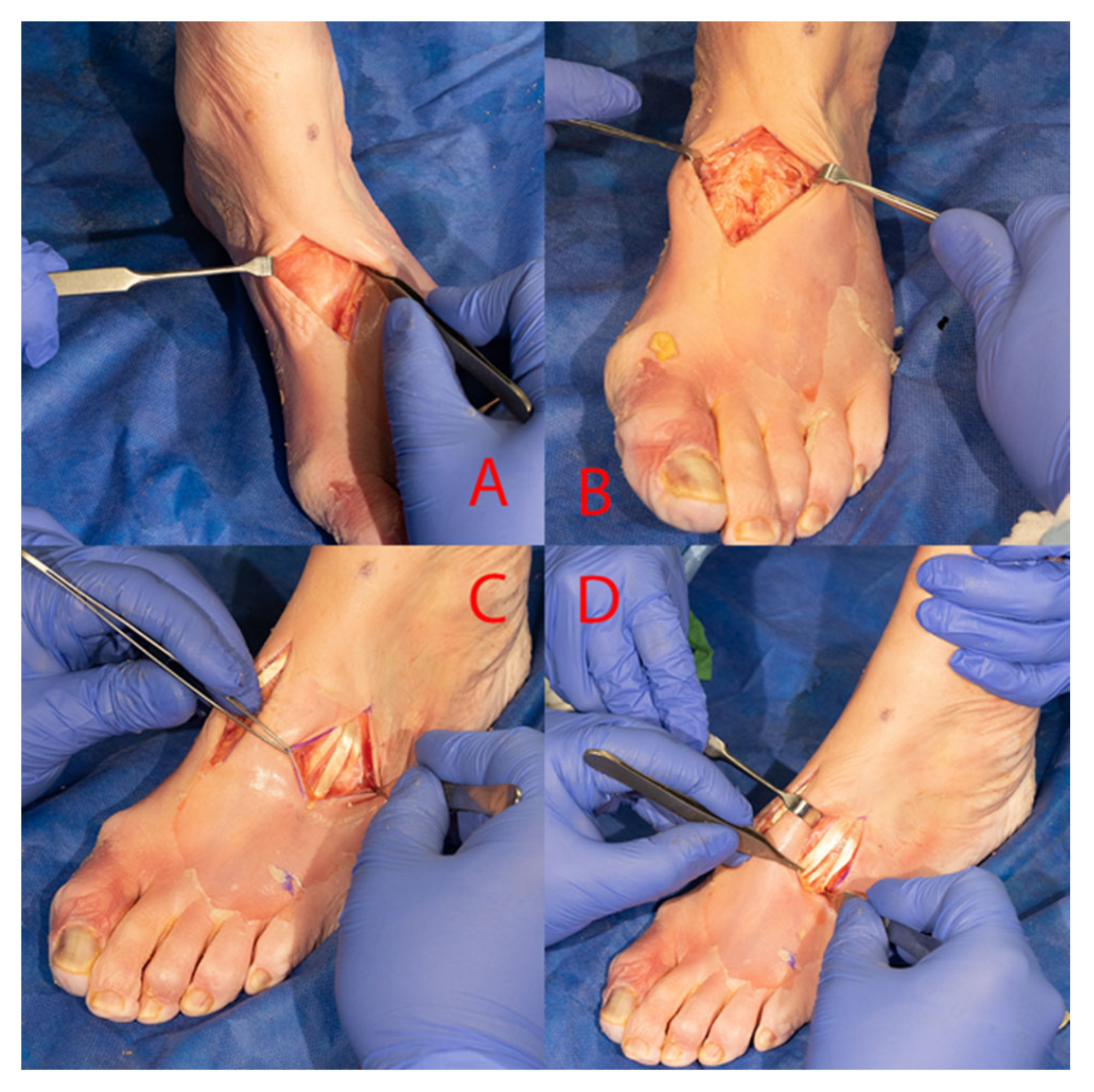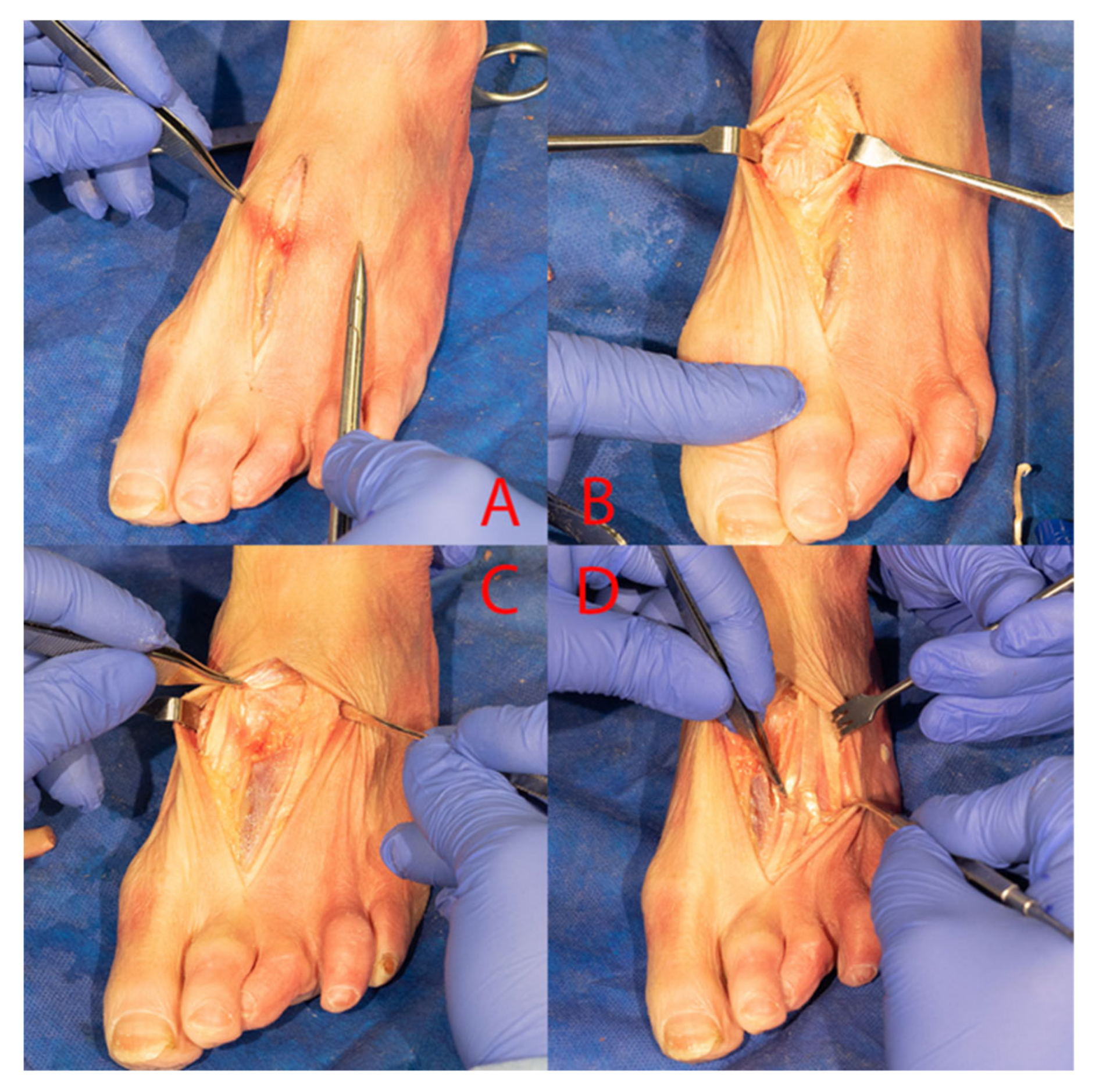Tarsometatarsal Joint Preparation Using a Modified Dorsal Approach vs. the Standard Approach: A Cadaver Study
Abstract
:1. Introduction
2. Materials and Methods
2.1. Standard (Dual Incision) Approach
2.2. Modified Dorsal (Single Incision) Approach
2.3. Articular Preparation, Imaging, and Statistical Analysis
2.4. Statistical Analysis
3. Results
4. Discussion
Author Contributions
Funding
Institutional Review Board Statement
Informed Consent Statement
Data Availability Statement
Conflicts of Interest
References
- Weatherford, B.M.; Anderson, J.G.; Bohay, D.R. Management of Tarsometatarsal Joint Injuries. J. Am. Acad. Orthop. Surg. 2017, 25, 469–479. [Google Scholar] [CrossRef] [PubMed]
- Ponkilainen, V.T.; Laine, H.J.; Mäenpää, H.M.; Mattila, V.M.; Haapasalo, H.H. Incidence and Characteristics of Midfoot Injuries. Foot Ankle Int. 2019, 40, 105–112. [Google Scholar] [CrossRef] [PubMed]
- Stødle, A.H.; Hvaal, K.H.; Enger, M.; Brøgger, H.; Madsen, J.E.; Ellingsen Husebye, E. Lisfranc injuries: Incidence, mechanisms of injury and predictors of instability. Foot Ankle Surg. 2020, 26, 535–540. [Google Scholar] [CrossRef] [PubMed]
- Watson, T.S.; Shurnas, P.S.; Denker, J. Treatment of Lisfranc joint injury: Current concepts. J. Am. Acad. Orthop. Surg. 2010, 18, 718–728. [Google Scholar] [CrossRef] [PubMed] [Green Version]
- Vertullo, C.J.; Easley, M.E.; Nunley, J.A. The Transverse Dorsal Approach to the Lisfranc Joint. Foot Ankle Int. 2002, 23, 420–426. [Google Scholar] [CrossRef] [PubMed]
- Treadwell, J.R.; Kahn, M.D. Lisfranc arthrodesis for chronic pain: A cannulated screw technique. J. Foot Ankle Surg. 1998, 37, 28–36. [Google Scholar] [CrossRef]
- Philpott, A.; Lawford, C.; Lau, S.C.; Chambers, S.; Bozin, M.; Oppy, A. Modified Dorsal Approach in the Management of Lisfranc Injuries. Foot Ankle Int. 2018, 39, 573–584. [Google Scholar] [CrossRef]
- Ly, T.V.; Coetzee, J.C. Treatment of primarily ligamentous Lisfranc joint injuries: Primary arthrodesis compared with open reduction and internal fixation. A prospective, randomized study. J. Bone Jt. Surg. Am. 2006, 88, 514–520. [Google Scholar] [CrossRef]
- Hu, S.J.; Chang, S.M.; Li, X.H.; Yu, G.R. Outcome comparison of Lisfranc injuries treated through dorsal plate fixation versus screw fixation. Acta Ortop. Bras. 2014, 22, 315–320. [Google Scholar] [CrossRef] [Green Version]
- Stavlas, P.; Roberts, C.S.; Xypnitos, F.N.; Giannoudis, P.V. The role of reduction and internal fixation of Lisfranc fracture-dislocations: A systematic review of the literature. Int. Orthop. 2010, 34, 1083–1091. [Google Scholar] [CrossRef] [Green Version]
- Henning, J.A.; Jones, C.B.; Sietsema, D.L.; Bohay, D.R.; Anderson, J.G. Open reduction internal fixation versus primary arthrodesis for lisfranc injuries: A prospective randomized study. Foot Ankle Int. 2009, 30, 913–922. [Google Scholar] [CrossRef] [PubMed]
- Quénu, E. Etude sur les luxations du metatarse (luxations metatarsotarsiennes) du diastasis entre 1 et le 2 metatarsien. Rev. Chir. 1909, 39, 1093–1134. [Google Scholar]
- Arntz, C.T.; Hansen, S.T., Jr. Dislocations and fracture dislocations of the tarsometatarsal joints. Orthop. Clin. N. Am. 1987, 18, 105–114. [Google Scholar] [CrossRef]
- Myerson, M.S.; Cerrato, R.A. Current management of tarsometatarsal injuries in the athlete. J. Bone Jt. Surg. Am. 2008, 90, 2522–2533. [Google Scholar]
- Arntz, C.T.; Veith, R.G.; Hansen, S.T., Jr. Fractures and fracture-dislocations of the tarsometatarsal joint. J. Bone Jt. Surg. Am. 1988, 70, 173–181. [Google Scholar] [CrossRef]
- Alberta, F.G.; Aronow, M.S.; Barrero, M.; Diaz-Doran, V.; Sullivan, R.J.; Adams, D.J. Ligamentous Lisfranc joint injuries: A biomechanical comparison of dorsal plate and transarticular screw fixation. Foot Ankle Int. 2005, 26, 462–473. [Google Scholar] [CrossRef]
- Marks, R.M.; Parks, B.G.; Schon, L.C. Midfoot fusion technique for neuroarthropathic feet: Biomechanical analysis and rationale. Foot Ankle Int. 1998, 19, 507–510. [Google Scholar] [CrossRef]
- Dahlgren, N.; Johnson, J.L.; Huntley, S.; McKissack, H.; Chinnakkannu, K.; Naranje, S.; Shah, A. First tarsometatarsal fusion using saw preparation vs. standard preparation of the joint: A cadaver study. Foot Ankle Surg. 2020, 26, 703–707. [Google Scholar] [CrossRef]
- Koury, K.; Staggers, J.R.; Pinto, M.C.; Godoy-Santos, A.L.; Smyth, N.A.; Shah, A.B.; de Cesar Netto, C. Radiographic Assessment of First Tarsometatarsal Joint Shape and Orientation. Foot Ankle Int. 2019, 40, 1438–1446. [Google Scholar] [CrossRef]
- Moracia-Ochagavía, I.; Rodríguez-Merchán, E.C. Lisfranc fracture-dislocations: Current management. EFORT Open Rev. 2019, 4, 430–444. [Google Scholar] [CrossRef]
- Sheibani-Rad, S.; Coetzee, J.C.; Giveans, M.R.; DiGiovanni, C. Arthrodesis versus ORIF for Lisfranc fractures. Orthopedics 2012, 35, e868–e873. [Google Scholar] [CrossRef] [PubMed] [Green Version]
- Parikh, S.; Dawe, E.; Lee, C.; Whitehead-Clarke, T.; Smith, C.; Bendall, S. A cadaveric study showing the anatomical variations in the branches of the dorsalis pedis artery at the level of the ankle joint and its clinical implication in ankle arthroscopy. Ann. R. Coll. Surg. Engl. 2017, 99, 286–288. [Google Scholar] [CrossRef] [PubMed] [Green Version]
- Ranade, A.V.; Rajanigandha, V.; Rai, R.; Ebenezer, D.A. Relationship between the deep peroneal nerve and dorsalis pedis artery in the foot: A cadaveric study. Clin. Anat. 2008, 21, 705–712. [Google Scholar] [CrossRef] [PubMed]
- Manjunatha, H.N. Variations in the origin, course and branching pattern of dorsalis pedis artery with clinical significance. Sci. Rep. 2021, 11, 1448. [Google Scholar] [CrossRef]



| Approach | Median Percent of the 1st TMT Joint Surface Prepared | p-Value | Median Percent of the 2nd TMT Joint Surface Prepared | p-Value | Median Percent of the 3rd TMT Joint Surface Prepared | p-Value |
|---|---|---|---|---|---|---|
| Standard (two incision) | 67.60% | 0.548 | 67.90% | 0.31 | 65.90% | 0.548 |
| Modified Dorsal (one incision) | 71.70% | 65.70% | 59.60% |
Publisher’s Note: MDPI stays neutral with regard to jurisdictional claims in published maps and institutional affiliations. |
© 2022 by the authors. Licensee MDPI, Basel, Switzerland. This article is an open access article distributed under the terms and conditions of the Creative Commons Attribution (CC BY) license (https://creativecommons.org/licenses/by/4.0/).
Share and Cite
Murali, S.; Littlefield, Z.; Young, S.; Andrews, N.A.; Levitt, E.; Agarwal, A.; Shah, A. Tarsometatarsal Joint Preparation Using a Modified Dorsal Approach vs. the Standard Approach: A Cadaver Study. Osteology 2022, 2, 99-105. https://doi.org/10.3390/osteology2020011
Murali S, Littlefield Z, Young S, Andrews NA, Levitt E, Agarwal A, Shah A. Tarsometatarsal Joint Preparation Using a Modified Dorsal Approach vs. the Standard Approach: A Cadaver Study. Osteology. 2022; 2(2):99-105. https://doi.org/10.3390/osteology2020011
Chicago/Turabian StyleMurali, Sudarsan, Zachary Littlefield, Sean Young, Nicholas A. Andrews, Eli Levitt, Abhinav Agarwal, and Ashish Shah. 2022. "Tarsometatarsal Joint Preparation Using a Modified Dorsal Approach vs. the Standard Approach: A Cadaver Study" Osteology 2, no. 2: 99-105. https://doi.org/10.3390/osteology2020011
APA StyleMurali, S., Littlefield, Z., Young, S., Andrews, N. A., Levitt, E., Agarwal, A., & Shah, A. (2022). Tarsometatarsal Joint Preparation Using a Modified Dorsal Approach vs. the Standard Approach: A Cadaver Study. Osteology, 2(2), 99-105. https://doi.org/10.3390/osteology2020011






